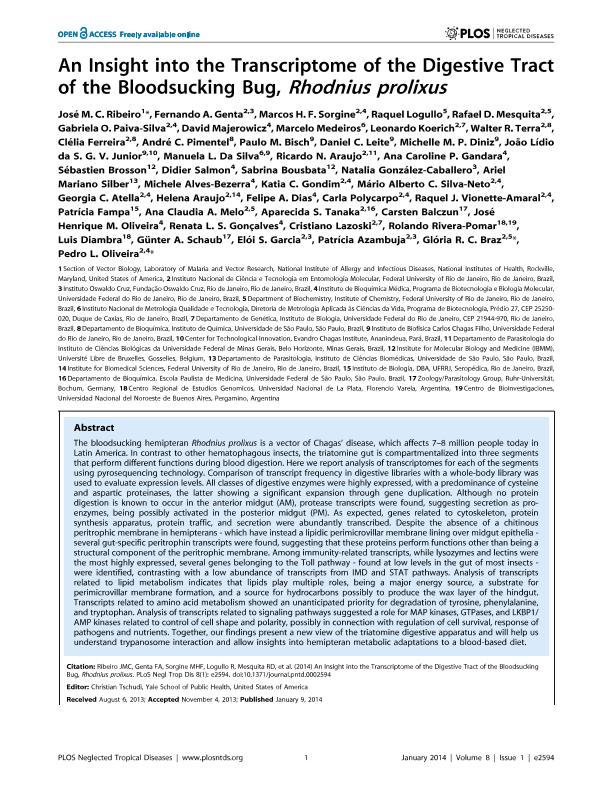Artículo
An Insight into the Transcriptome of the Digestive Tract of the Bloodsucking Bug, Rhodnius prolixus
Ribeiro, José M. C.; Genta, Fernando A.; Sorgine, Marcos H. F.; Mesquita, Rafael D.; Paiva Silva, Gabriela O.; Majerowicz, David; Medeiros, Marcelo; Koerich, Leonardo; Terra, Walter R.; Ferreira, Clelia; Pimentel, Andre C.; Bisch, Paulo M.; Leite, Daniel C.; Diniz, Michelle M. P.; Da Silva, Manuela L.; Araujo, Ricardo N.; Gandara, Ana Caroline P.; Brosson, Sebastien; Salmon, Didier; Bousbata, Sabrina; Gonzalez Caballero, Natalia; Alves Bezerra, Michele; Katia C. Gondim; Silva Neto, Mario Alberto C.; Atella, Georgia C.; Araujo, Helena; Dias, Felipe A.; Polycarpo, Carla; Vionette Amaral, Raquel J.; Fampa, Patricia; Melo, Ana Claudia A.; Tanaka, Aparecida S.; Balczun, Carsten; Oliveira, J. Henrique M.; Goncalves, Renata L. S.; Lazoski, Cristiano; Rivera Pomar, Rolando ; Diambra, Luis Anibal
; Diambra, Luis Anibal ; Schaub, Gunter A.; Garcia, Eloi S.; Azambuja, Patricia; Braz, Gloria R. C.; Oliveira, Pedro L.
; Schaub, Gunter A.; Garcia, Eloi S.; Azambuja, Patricia; Braz, Gloria R. C.; Oliveira, Pedro L.
 ; Diambra, Luis Anibal
; Diambra, Luis Anibal ; Schaub, Gunter A.; Garcia, Eloi S.; Azambuja, Patricia; Braz, Gloria R. C.; Oliveira, Pedro L.
; Schaub, Gunter A.; Garcia, Eloi S.; Azambuja, Patricia; Braz, Gloria R. C.; Oliveira, Pedro L.
Fecha de publicación:
01/2014
Editorial:
Public Library of Science
Revista:
Neglected Tropical Diseases
ISSN:
1935-2735
Idioma:
Inglés
Tipo de recurso:
Artículo publicado
Clasificación temática:
Resumen
The bloodsucking hemipteran Rhodnius prolixus is a vector of Chagas’ disease, which affects 7–8 million people today in Latin America. In contrast to other hematophagous insects, the triatomine gut is compartmentalized into three segments that perform different functions during blood digestion. Here we report analysis of transcriptomes for each of the segments using pyrosequencing technology. Comparison of transcript frequency in digestive libraries with a whole-body library was used to evaluate expression levels. All classes of digestive enzymes were highly expressed, with a predominance of cysteine and aspartic proteinases, the latter showing a significant expansion through gene duplication. Although no protein digestion is known to occur in the anterior midgut (AM), protease transcripts were found, suggesting secretion as proenzymes, being possibly activated in the posterior midgut (PM). As expected, genes related to cytoskeleton, protein synthesis apparatus, protein traffic, and secretion were abundantly transcribed. Despite the absence of a chitinous peritrophic membrane in hemipterans - which have instead a lipidic perimicrovillar membrane lining over midgut epithelia - several gut-specific peritrophin transcripts were found, suggesting that these proteins perform functions other than being a structural component of the peritrophic membrane. Among immunity-related transcripts, while lysozymes and lectins were the most highly expressed, several genes belonging to the Toll pathway - found at low levels in the gut of most insects - were identified, contrasting with a low abundance of transcripts from IMD and STAT pathways. Analysis of transcripts related to lipid metabolism indicates that lipids play multiple roles, being a major energy source, a substrate for perimicrovillar membrane formation, and a source for hydrocarbons possibly to produce the wax layer of the hindgut. Transcripts related to amino acid metabolism showed an unanticipated priority for degradation of tyrosine, phenylalanine, and tryptophan. Analysis of transcripts related to signaling pathways suggested a role for MAP kinases, GTPases, and LKBP1/ AMP kinases related to control of cell shape and polarity, possibly in connection with regulation of cell survival, response of pathogens and nutrients. Together, our findings present a new view of the triatomine digestive apparatus and will help us understand trypanosome interaction and allow insights into hemipteran metabolic adaptations to a blood-based diet.
Palabras clave:
Transcriptomic
,
Rhodnius Prolixus
,
Annotation
,
Digestive Tract
Archivos asociados
Licencia
Identificadores
Colecciones
Articulos(CCT - LA PLATA)
Articulos de CTRO.CIENTIFICO TECNOL.CONICET - LA PLATA
Articulos de CTRO.CIENTIFICO TECNOL.CONICET - LA PLATA
Citación
Ribeiro, José M. C.; Genta, Fernando A.; Sorgine, Marcos H. F.; Mesquita, Rafael D.; Paiva Silva, Gabriela O.; et al.; An Insight into the Transcriptome of the Digestive Tract of the Bloodsucking Bug, Rhodnius prolixus; Public Library of Science; Neglected Tropical Diseases; 8; 1; 1-2014; 259401-e259431
Compartir
Altmétricas



